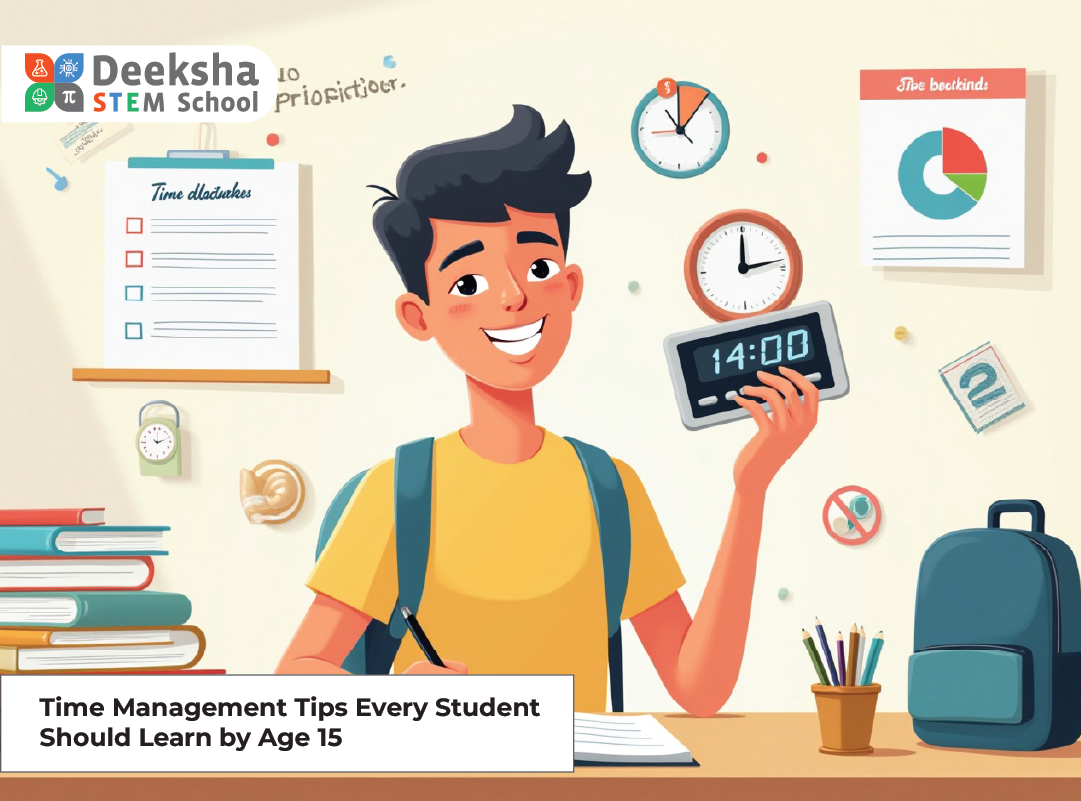Raising Independent Thinkers: A Parent’s Guide to Letting Kids Take Charge

Children who grow up to be confident decision-makers, self-learners, and creative problem-solvers often have one thing in common: they were encouraged to think independently from a young age. In a world where adaptability, innovation, and critical thinking are essential skills, fostering independence is one of the most valuable gifts a parent or educator can offer.
Encouraging autonomy doesn’t mean removing structure or guidance—it means creating a balanced environment where children feel safe to express themselves, take initiative, and learn from both success and failure. The journey to independence starts early and evolves with every stage of a child’s growth.
At Deeksha STEM Schools, we believe in a holistic approach that supports not only academic excellence but also emotional intelligence and leadership. Here’s a deep dive into how parents can contribute to raising self-driven, thoughtful individuals—and how our campuses are designed to support that journey.
Why Independent Thinking Matters
Independent thinking helps children approach life with confidence and curiosity. It empowers them to solve problems, think critically, and take responsibility for their actions. More than just academic outcomes, it influences how children handle relationships, career choices, and personal growth.
| Benefit | Impact on a Child’s Growth |
| Improves decision-making | Children learn to weigh options, anticipate outcomes, and accept consequences |
| Boosts self-confidence | Making and owning decisions nurtures self-assurance and pride in personal achievements |
| Encourages creativity | Exploring multiple approaches without fear fuels innovation and resourcefulness |
| Fosters leadership | Being self-directed helps children take charge in group settings, both in school and beyond |
| Builds resilience | Facing challenges and setbacks on their own builds perseverance and mental strength |
| Enhances accountability | Understanding the impact of choices encourages responsibility for actions |
| Promotes lifelong learning | Independent thinkers are curious learners who seek out knowledge even beyond the classroom |
Signs Your Child is Ready for Independence
Not all children display independence in the same way. However, certain behaviors indicate growing readiness:
- Expresses curiosity with questions like “why” and “how”
- Makes simple decisions without prompting
- Attempts daily tasks like dressing or packing bags on their own
- Accepts when things go wrong and tries again
- Demonstrates empathy and understanding of how their actions affect others
Recognizing these signs allows parents to increase opportunities for autonomy gradually and meaningfully.
Strategies to Raise Independent Thinkers
Fostering independence requires consistency, patience, and trust. Here are effective strategies to help children become self-sufficient learners and leaders:
1. Give Choices with Boundaries
Offer your child age-appropriate choices, such as what snack to eat or which activity to do first. This builds their decision-making ability while providing a sense of control within a safe framework.
2. Encourage Problem-Solving
Rather than immediately offering solutions, prompt your child to think through a challenge. Ask questions like:
- “What do you think might work here?”
- “How else could we approach this problem?”
- “What happened the last time you tried something similar?”
3. Promote Critical Thinking
Expose your child to new ideas and perspectives. Discuss news stories, ethical dilemmas, or events from their day. Encourage them to evaluate information and consider different viewpoints before forming opinions.
4. Let Them Experience Consequences
Natural consequences are some of life’s greatest teachers. If they forget their homework, let them face the feedback. If they overspend their allowance, don’t top it up immediately. This instills responsibility and accountability.
5. Praise Effort, Not Just Outcome
Focus your praise on the effort, strategy, and thought process—not just the final result. This builds a growth mindset and encourages children to keep trying even when things get tough.
6. Model Independence
Children learn by example. Narrate your own decision-making process aloud:
- “I’m thinking about which route to take because of traffic.”
- “I made a mistake, but here’s how I plan to fix it.”
This helps normalize thoughtful evaluation and problem-solving.
7. Assign Meaningful Responsibilities
Chores, pet care, and household tasks contribute to a child’s understanding of their role in the family unit. It gives them real-life practice in ownership, consistency, and follow-through.
8. Build a Safe Space for Mistakes
Create an environment where your child isn’t afraid of failure. Mistakes should be seen as opportunities for growth, not reasons for shame.
How Deeksha STEM Fosters Independent Thinking
Our approach to education at Deeksha STEM goes beyond textbooks and lectures. We nurture independence through integrated academic experiences and co-curricular opportunities:
- Project-Based Learning: Students choose research topics, plan execution steps, and present outcomes. This ownership fosters creativity, responsibility, and initiative.
- Classroom Discussions: We encourage open dialogue where students present arguments, counterpoints, and opinions respectfully. This cultivates intellectual independence.
- Mentorship Programs: Our mentor-guided one-on-one sessions provide space for students to reflect on goals, challenges, and progress with encouragement to take charge.
- Innovation Labs: Through robotics, design thinking, and coding labs, students take on self-directed explorations that build analytical and technical independence.
- Student Leadership Roles: Council elections, club leadership, and peer tutoring programs empower students to lead and influence others positively.
- Digital Portfolios: Students maintain progress logs and reflections, encouraging self-monitoring and goal alignment.
Frequently Asked Questions
1. At what age should I start encouraging independence?
You can begin as early as age 2 with simple tasks like tidying up toys or picking out clothes. As your child matures, you can expand the responsibilities gradually, based on their emotional and cognitive readiness.
2. Can too much independence backfire?
Yes, when it’s unbalanced. Children still need structure and emotional guidance. Too much freedom without boundaries can lead to confusion or risky choices. The key is scaffolding—providing the right amount of support as they grow.
3. How do I help my child make better decisions?
Model good decision-making. Use daily opportunities to talk through options, outcomes, and lessons learned. Let your child try, reflect, and try again—without stepping in too quickly.
4. How does Deeksha STEM build independence in academics?
Through structured yet flexible learning paths. Our students set personal goals, manage projects, participate in peer reviews, and take ownership of their academic plans with mentor support.
5. What if my child is afraid to make decisions?
Fear of making the wrong choice is common. Start by offering low-risk choices. Acknowledge their fear and walk through possible outcomes together. Celebrate both courage and reflection—this builds confidence over time.
Final Thoughts
Raising an independent thinker isn’t about letting go—it’s about gradually stepping back and letting your child take the lead, while you cheer from the sidelines. Independence doesn’t happen overnight. It’s built through everyday moments, consistent encouragement, and the trust that your child can and will grow into their best self.
At Deeksha STEM Schools, we create an environment that balances guidance with freedom, and support with challenge. Our aim is to shape students who not only succeed academically but who think deeply, act responsibly, and lead courageously.
Visit our campuses at Bannerghatta Road, Judicial Layout, Kengeri, and Vidyanagar to discover how we’re cultivating tomorrow’s leaders—one independent thinker at a time.




